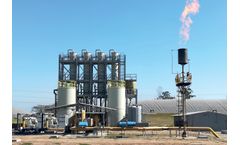Biogas H2s Control Articles & Analysis: Older
5 articles found
Fluence technology scrubs hydrogen sulfide from biogas before it's used to generate electricity. The Fluence biogas desulfurization system installed at the Citrusvil plant uses four washing columns as well as two oxidation tanks. Citrusvil, a large, South American citrus-processing company, has a focus on building sustainability into its production systems. This extends to using waste-to-energy ...
A farm-scale biogas desulfurization system was designed and tested for H2S removal efficiency from livestock biogas. This work assesses the H2S removal efficiency of a novel farm-scale biogas bio-desulfurization system (BBS) operated for 350 days on a 1,000-head pig farm. Experimental data demonstrated that suitable humidity and temperature can help sulfur-oxidizing bacteria to form active ...
The microaerobic removal of H2S was studied to determine the treatment capacity at low and high H2S concentrations in the biogas (0.33 and 3.38% v/v) and to determine the optimal O2 rate that achieved a concentration of H2S of 150 mg/Nm3 or lower. ...
The paper reviews results and experience of microaerobic experiments at both high and low sulphide concentrations and evaluates advantages and drawbacks of the anaerobic digestion of sludge in microaerobic conditions as regards biogas quality, digested sludge quality, organic pollutants biodegradability and methanogenic activity of biomass. The innovative microaerobic modification of the ...
Biogas contains about 65% methane, 30-35% carbon dioxide, traces of hydrogen sulphide and moisture. It has been observed that diesel engines get severely damaged when operated on biogas for long duration. Presence of these corrosive gases make biogas unsuitable for transportation application. By removing CO2 and trace acidic gases like H2S and moisture, biogas can be converted into natural gas ...



